How It Works – Your Quick Guide to Charity, Outreach & Community Topics
Ever wonder what really happens behind the scenes of a charity or a community project? You’re not alone. Most people see a donation receipt or a flyer and assume the work is done. In reality, there are clear steps, roles, and tools that turn good intentions into real impact.
On this page you’ll get a fast‑forward look at the mechanics of the most popular posts on our site. From writing a solid outreach plan to picking the best environmental charity, we break down the process into bite‑size actions you can start today.
Running a Community Outreach Program
First, figure out the core goal: are you trying to raise awareness, connect people with services, or solve a specific problem? Write that goal in one sentence and keep it front and center. Next, map out the key players – volunteers, local NGOs, government offices – and note what each can contribute. A simple spreadsheet works better than a fancy flowchart; list tasks, deadlines, and who’s responsible.
When you draft your outreach plan, follow a step‑by‑step checklist: define the audience, choose the right communication channel (social media, flyers, door‑to‑door), set measurable metrics (like the number of sign‑ups or resource referrals), and schedule a review after the first month. Real‑world examples show that programs that track a single metric, such as “new households reached,” adjust faster and see better results.
Choosing and Supporting Effective Charities
If you want to give money, start by checking transparency scores. The top‑rated charities publish annual reports, disclose admin costs, and show clear outcomes. Look for a track record of impact – for example, an environmental group that can point to acres of forest saved or a homeless shelter that reduced street sleeping by a measurable percentage.
Don’t just pick the biggest name. Smaller, local charities often have lower overhead and can adapt quickly. Use a simple three‑question filter: (1) Does the charity solve a problem you care about? (2) Can you verify where the money goes? (3) Is there a clear way to measure success? If you answer yes to all three, you’re likely on the right track.
Beyond money, your time and skills are valuable. Volunteer shortages are real, and many NGOs need help with event planning, social media, or data entry. Pick a task that matches your strengths – a teacher could run an after‑school snack program, while a marketer could craft outreach messages.
Finally, keep the feedback loop open. Ask the organization for updates on how your contribution helped. Seeing tangible results keeps you motivated and helps the charity improve its methods.
Whether you’re writing a community outreach plan, selecting an environmental charity, or looking for local support groups, the process shares a common thread: set a clear goal, map out concrete steps, track one or two key outcomes, and review regularly. That simple loop turns ideas into actions you can see and feel.
Remember, you don’t need a degree in nonprofit management to make a difference. Start with one small project, apply the steps above, and watch the impact grow. Keep checking back for new guides on topics like homeless resources in Richmond, after‑school snack ideas, or low‑cost fundraising – each follows the same “how it works” formula we’ve outlined here.
Charitable Trust: What Is Its Purpose and How Does It Work?
Ever wondered why people set up charitable trusts? This article breaks down what a charitable trust is and why folks use them. You'll see real-world reasons and learn what makes them different from regular donations. If you're thinking about giving back or handling your estate, this guide spells out the basics. Plus, you'll pick up some useful tips to make your donations go further.
Read More